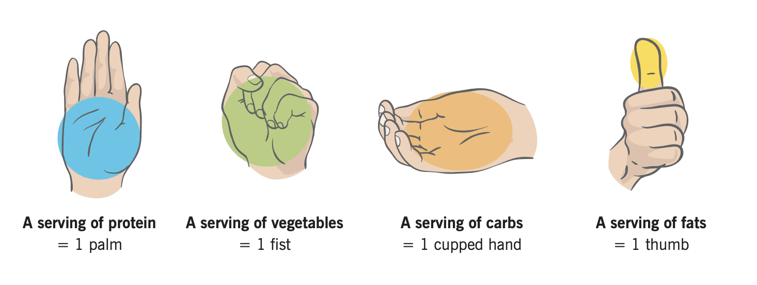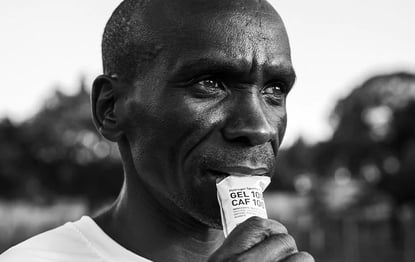FUELING YOUR RUN: FINDING THE RIGHT FOOD
October 26, 2022
Fueling for performance is an important nutrition skill that takes time and practice. You may have read how we approach our hydration by understanding your body's needs over time. Together we'll understand how to fuel your long run or marathon training cycle that can also be applied to most endurance training plans.

IF YOUR GOAL IS TO GO LONG
Whether you're committed to a marathon training plan, sprint triathlon, Ironman, or preparing for a series of games on a tournament weekend, you have to look at food differently. In most scenarios, you are fueling your body in motion for at least 2+ hours which warrants intake to be easily digestible, enjoyable, and strategic.
STEP 1: MAKE SURE YOUR REGULAR MEALS ARE WHOLE AND PLENTIFUL
You need to master your basic everyday meals, the meals surrounding your runs or training sessions, to help you understand what works for your body. Our coaches and therapists like to encourage clients to find the right macronutrient balance with predominately whole foods. This can be intuitive and simple by how you portion your meals. A quick reference and guide to help frame your meals can be found here.
Nutrition coaching at MOTIVNY is centered around basic nutrition skills. For an endurance athlete, you need to make sure you are eating enough. Eating too much or too little can leave you sluggish or irritable which can hold you back in a way that makes you feel out of control. Your basic caloric need is varied based on your body weight, body composition (specifically how much muscle you carry and maintain), and training schedule.
Precision Nutrition's Hand Portion Model:

2x per meal for Men, 1x per meal for Women, 3-4x/day depending on weight and exercise activity.]
The suggestion is to start with three meals with the above portion guide but to notice how you're feeling before, during, and after your meals. This takes time and works best with eating slowly or eating 80% full (approximately 20-30 minutes/meal). If you need a refresher take a look at our mindful eating article here. Pairing these "anytime" meals with your hydration strategy will give you a solid foundation and is necessary for sustaining a healthy training schedule. You will also need to learn to recognize your hunger cues and eat well in your off-training times before you think about creating a long-distance fueling strategy, as the latter is an extension of the foundations built in the former.
STEP 2: COMPLEX CARBS vs SIMPLE CARBS
When you're loading your plate with the guidance above, you'll start to notice the difference between certain carbohydrate sources.
We have grains, legumes, leafy greens, and various starches (think potatoes or tubers) that take more time to digest due to the fiber and protein they possess. These choices are commonly prepared with healthy fats that naturally slow down digestion to keep you satiated. These whole food sources are known as "complex carbs" and are very nutrient-dense and vital for managing blood sugar and regulating digestion.
When the body is in motion for more than 45 minutes, these options may be harder to digest and may cause some discomfort when consumed on the move. The fiber may trigger a bowel movement or create discomfort which is not ideal when performing a long run or engaging in a series of events (spartan race, half ironman, ironman, etc.).
When fueling on the go, we want to choose foods that digest quickly and easily. In a race or tournament that lasts more than 2hrs, you can load your body upwards of 8g of carbohydrates per kilogram of body weight. This can help keep your muscles and mindset focused. 
THE RECOMMENDATION:
-Maurten Gels, Solids, and Hydration Mix
-maple syrup or honey variations
-sweet rice cake of your choice or any white rice variation
-whole fruit (preferably ripe and already cut up or mashed)
STEP 3: EAT MINDFULLY + TIMING
When digesting sugar, your saliva plays a crucial role in breaking down sugar. The saliva in your mouth possesses an enzyme, salivary amylase, to break down and digest sugar properly. This aids digestion which is sensitive on a long run or endurance event.
The best practice here is to keep your sugar of choice in your mouth for at least 30 seconds and up to two minutes. This helps your body metabolize and break down the sugar efficiently. Some people prefer gummies or chews because they intuitively have to slow down their intake by chewing and savoring.
Your decisions can be outcome-based with consistency and practice. See what works best for you with timing and in the food choices that cooperate with your digestion. This brings us back to the skill of eating slowly and eating 80% full in your core meals so you have for and respect in your body.

YOUR RUNNING FUEL + HYDRATION TIMELINE
The timeline below is for any long run that exceeds 45minutes. Follow this template to help you prepare for your race while also making any necessary changes to accommodate your body.
6am: WAKE UP
6:15-6:45am: FULL ANYTIME MEAL + HYDRATION
Take a mental check-in, bowel movement, and add the movement prep you need.
7:30-8am: PREGAME YOUR RUN
500ml-1L h20 + electrolytes + 40-60g of a solid carbohydrate source (with the expectation you have a restroom handy)
Save your gels for your run (50-80g carbohydrates per hour of continuous running)
8am: START YOUR RUN
Going forward, after your first 45 minutes of continuous exercise, check in with both hydration and fuel every 30 minutes or at least every hour of continuous activity. Ranges fluctuate depending on how well you're digesting, how much you sweat, and how well your body uses fuel (carbohydrates/fats).
1 HR OF WORK = 500-1L of Electrolytes and H2O
1 HR of WORK = 50-75g of Carbohydrates (this may change +/-)
If you're fueling for performance, you don't have to wait until you are hungry to fuel. Anticipate your needs by following the template above and practice how much you can eat while on the move.
Most importantly have fun and embrace the changes along the way. You're going to find a unique rhythm and strategy specific to your needs, so embrace the choices that work best for you.

